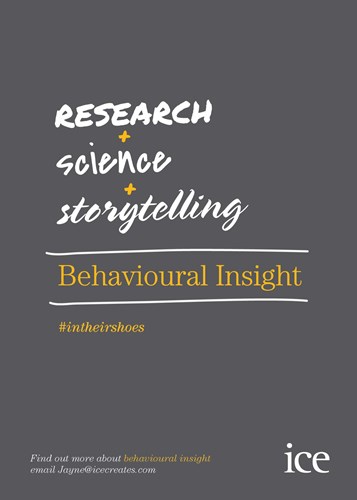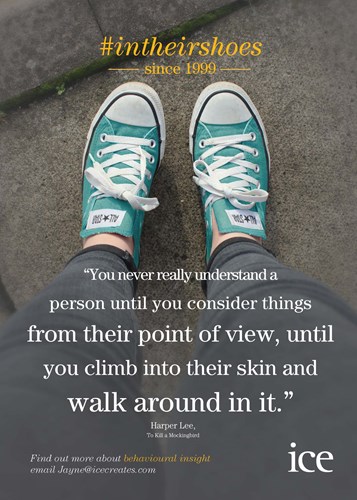After ICE was commissioned by a council to reduce alcohol consumption in 18-25 year old women, I tried to recall what was already out there. As a 25 year old woman, I knew I was being targeted but I could not for the life of me place when, where or how an existing campaign had impacted my decision-making when it came to alcohol. This isn’t to say I had never seen one. In fact, I had seen and heard so many that they became a bit like the coat rack in my flat. I know it’s there and I know its benefits (I bought it as a solution to my bad habit of scattering my possessions as a kind of trail that my partner can follow to find me), but I just cannot bring myself to use it without a prompt. In a market that is saturated with so much noise, how could we connect with 18-25 year old women in a way that would resonate with them, as well as nudging them towards changing their drinking patterns?
Another key factor to consider is culture. It can be incredibly frustrating to announce you’re not drinking alcohol on a night out, or during a night in with friends. In my experience, the only ‘accepted’ norms for not drinking are those with links to religion, medical reasons, being the designated driver, pregnancy or alcohol abuse (experienced first person or through a family member/close friend/partner). If your reason for not drinking doesn’t fit into these categories, then all too soon, you can find yourself being accused of being ‘boring’, ‘putting a downer on the night’ or being asked ‘why did you even come out?’
In a society where the term ‘binge drinking’ has seemingly lost all impact, how could we connect with these women to create a shift in their relationship with alcohol?
Let’s be honest – it’s not shocking to read that high alcohol consumption can cause serious negative consequences in both the short-term (accident/injury) and in the long-term (chronic liver disease). I am equally familiar with the fact that drinking alcohol at a young age increases the risk of alcohol dependency or abuse later in life.
Key insights:
During ICE’s research, it was discovered that - owing largely to a national campaign called ‘know your limits’ - young women define responsible drinking as drinking to their own perceived limit. However, they define this limit as a state when they are highly intoxicated and vulnerable. Young women are aware of drink protective behavioural strategies (such as drinking water, slowing down, spacing their drinks out), but in real time drinking terms, this can mean that the damage is already done as these changes in behaviour were found to only be implemented once they had hit their self-imposed and normalised ‘limit’.
Reaching this limit was described as ‘can’t see straight’, ‘the floor is moving’ and ‘I see double.’ Although this did serve as a nudge to deter more alcoholic drinks, this is too late to reduce their risk of short-term negative impacts of alcohol consumption.
Young women were clear that posters that included visuals and messaging that told them to stop drinking or drink responsibly would not change their behaviour. Are these posters no more than a tick-box exercise, serving as a ‘well done’ to everyone involved in the campaign for radicalising the world of young women and alcohol? In my opinion, there is a lot to be answered for when it comes to message frames that place the onus on the individual to judge their own actions using their own moral compass, without providing any attempt to educate, inform or alter the judgement of the individual. These posters often contain shocking statistics and graphic depictions of what can go wrong when drinking alcohol, but they often lack the basic understanding of the audience they are supposed to appeal to, and can come across as patronising and judgemental. So, what do these women who are drinking to excess actually respond to, and what will increase their engagement with these behaviour change messages?
Importantly, we identified that the young women’s judgement of whether they had reached their limit relies heavily on their visual acuity – when they judge they can’t see properly, they change their behaviour. Accordingly, using their subconscious mind to nudge them to judge that their vision was failing is likely to change their behaviour sooner and reduce the risk of negative consequences. Many of the decisions we make are not rational and are made without us consciously thinking about them. These nudges position themselves within the subconscious of an individual, and are consequently more proactive than reactive when it comes to behaviour change.
Solution:
ICE designed a series of behavioural nudges (e.g. blurred images in toilet mirrors) that were employed in situ at pubs and clubs to use young women’s unconscious thoughts and nudge them to self-identify that they may be approaching their limit, thus enabling them to apply drink protective behavioural strategies more proactively.
Because we rarely use rational decision making processes when deciding when and how much to drink (common reasons include 'it’s fun', 'relaxing' and 'social'), strategies that appeal to such rational decision making (including those that focus on the serious negative consequences of drinking) are unlikely to have a significant impact on reducing how much and how frequently young women drink alcohol. While they may look great and convince everyone in the commissioned agency that they are going to have the desired outcome, they simply get lost when they are applied in the real world and serve as more of a constant cliché than an effective and sustained behaviour change campaign.
By working with young women’s unconscious thoughts and feelings, we were able to nudge these women towards self-identifying that they were nearing their limit (instead of already having hit it). This novel approach changes this maladaptive behaviour and helps to reduce incidences of the serious negative consequences of drinking alcohol.
If you would like to find out more about this campaign or ICE’s approach to behaviour change, feel free to contact myself or Dr Adam Moore, who is ICE’s Head of Applied Behavioural Insights, on 0151 647 4700 or at klara.davidson@icecreates.com / adam.moore@icecreates.com
- Klara Davidson
 collective voice
collective voice
